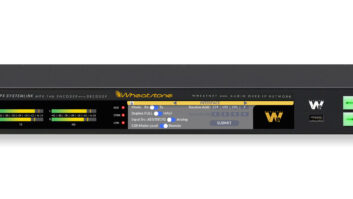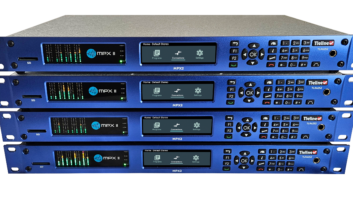The author is senior product design engineer for Wheatstone
NEW BERN, North Carolina — With 100 kHz FM channel spacing and short station-to-station geographical spacing, many European countries employ a broadcasting regulation intended to reduce adjacent channel interference. Accomplishing this feat requires reducing an FM station’s average RF sideband energy by reducing multiplex power.
Unfortunately, multiplex power and loudness are directly related, so asking radio stations to “voluntarily” reduce loudness is tantamount to asking them to turn off their transmitters. A mandatory modulation standard was therefore created, ITU-R BS.412-7, which requires FM stations in certain European countries to measure, and to never exceed, a predefined value of maximum multiplex power.
Regulatory intervention of FM loudness became necessary because as the RF spectrum of a station’s broadcast channel is “filled up” with dense program modulation interference to adjacent stations becomes more likely. Further complicating the issue is that modern FM audio processors do an extremely good job of generating the dense program modulation required to “fill up” those FM broadcast channels.
Figures 1 and 2 show time-based measurements of peak deviation versus time for two competitively processed FM stations. Both employ the same audio processor and settings, but the station represented in Figure 2 has its processor’s BS.412 multiplex power controller enabled. The station in Figure 1 is achieving 75 kHz deviation almost continuously, while the station in Figure 2 only occasionally achieves 75 kHz deviation.


Figure 1: BS.412 MPX Power Controller “Off”Figure 2: BS.412 MPX Power Controller “On”
MEASURING, CONTROLLING MULTIPLEX POWER
Special measuring equipment was designed for verifying multiplex power according to the ITU-R BS.412-7 standard. This equipment performs wideband detection of signals within the 100 kHz stereo baseband spectrum, squares the detected signal to represent “power,” and then integrates the result over a rolling 60-second period. The equipment can display a station’s multiplex power as a number referenced to 0 dBr, or graphically, in order to provide histograms of peak or average multiplex power over time.
It is natural to assume that a “perfect” multiplex power controller might simply use the same 60-second rolling average the analyzers use as the timing for the control loop. But that approach results in the desired control always arriving too late to be effective.
It would also be natural to assume that very fast multiplex limiting could squash the energy into submission, and that approach certainly does work. But it also creates objectionable processing artifacts such as gain pumping while doing an exemplary job of keeping multiplex power pegged right up to the legal limit.
All multiplex power controllers add yet another layer of processing on top of what is already being done by the processor, but Wheatstone’s philosophy is that the role of the audio processor is to present pleasing content and control modulation.
We began to experiment with a program-dependent prediction, detection and measurement algorithm that continuously adapts the controller’s behavior to the incoming program content. We placed the algorithm, or what we now call the Multiplex Power Wizard, early in the signal path in order to permit it to be aware of audio power increases generated by all prior processing, including pre-processing that may have occurred prior to the processor. Energy increases contributed by the main and composite clippers are also accounted for. We discovered that with this scheme, it doesn’t matter how hard the clippers are driven, nor does it matter what pre-emphasis curve is in effect. Multiplex power is always and effectively controlled.
Figure 3 shows where we located the algorithm in the signal path of Wheatstone FM-55 audio processors and SG-192 stereo generators.

Figure 3: FM-55 and SG-192 Software Version 1.2.19 and later
Figure 4 represents illustrates a measurement plot representing a two-hour recording of multiplex power while an FM-55 was operating with the algorithm. The FM-55 was processing a wide variety of audio content and using the “BS412_0dB_Aggressive” factory preset. The power curve slightly left of 01:00:00 (see time scale at bottom) reflects the controller’s behavior during a segment of talk programming — average multiplex power is reduced even though 75 kHz maximum peak deviation was consistently achieved. An Audemat DFMA02 analyzer performed the measurement.

Figure 4: A measurement plot representing a two-hour recording of 1.2.19 and later. multiplex power while an FM-55 was operating with the algorithm.
Notably absent is the control-related artifacts typi- cally heard. This algorithm is now standard in our FM-55 audio processors and SG-192 stereo generators running software version 1.2.19 (or higher).
Radio World welcomes other points of view. Please send comments to [email protected]












